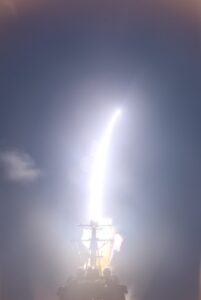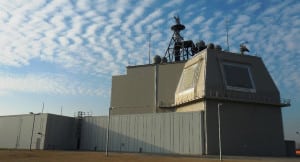The final version of the 2021 defense policy bill puts the brakes on funding a wider layered missile defense system without additional reports and cuts Aegis funds requested for the effort.
The administration requested $815 million in research and development funds to look at using Aegis ballistic missile defense systems to help bolster homeland missile defenses. The Defense Department planned to explore using Aegis Standard Missile-3 (SM-3) Block IIA interceptors and/or Terminal High Altitude Area Defense (THAAD) batteries to provide a layered homeland missile defense system to augment the current Ground-based Midcourse Defense (GMD) System with its interceptors in Alaska and California. GMD aims to protect the U.S. from intercontinental ballistic missile (ICBM) threats.

This effort comes in the wake of an MDA and Navy test that used an SM-3 IIA missile launched from a destroyer to successfully intercept an ICBM-representative target near Hawaii (Defense Daily, Nov. 17).
In April, Deputy Assistant Secretary of Defense for Nuclear and Missile Defense Policy Robert Soofer noted “if the SM-3 IIA is capable of intercepting a North Korean-representative ICBM threat, this opens up some possibility to use the SM-3 IIA as an underlay to the GMD system” (Defense Daily, April 22).
Soofer said if the capability works the U.S. probably needs SM-3 IIAs deployed in an Aegis Ashore model rather than relying only on missiles based on Arleigh Burke-class destroyers.
In July, Adm. Phil Davidson, head of U.S. Indo-Pacific Command, said getting an Aegis Ashore system on Guam by 2026 is his number one priority to bolster defenses against advancing Chinese missile capabilities. He added the current THAAD plus an Aegis destroyer are currently only meant to defend against a rogue North Korean missile shot (Defense Daily, July 22).
While the Senate’s version of the FY ’21 national defense authorization act approved the Defense Department’s full Aegis underlayer funding request, the House bill cut $10 million. The final conference report ended up cutting nearly $40 million from the $815 million request to $775 million.
The report said this reduction is due to “insufficient justification Aegis underlay and unjustified cost growth.”
The Senate bill also fenced off half the funds MDA requested for a layered homeland defense system until the congressional defense committees receive a detailed report because “the committee notes that the Department has provided very little information or analysis to support this proposal, despite including substantial funding within the MDA budget for this purpose” (Defense Daily, June 25).
In contrast, the House bill contained a similar provision that required the Director of Cost Assessment and Program Evaluation (CAPE) conduct an analysis of alternatives for the layered homeland defense architecture using THAAD and the Aegis system as well as require elements of the intelligence community to provide the defense committees an assessment of other countries’ perceptions of the system and their likely responses.
The House receded to the Senate version with its fencing of funds while adding several requirements to the report, largely covering its previous directives.
In the final bill, the Secretary of Defense is directed to submit a report on the proposed layered homeland defense missile defense architecture to the congressional defense committees by March 1.
The report is to include: a description of the requirements for the layered missile defense architecture based on an assessment by the intelligence community of threats to be addressed at the time of deployment and validated by the Joint Requirements Oversight Council (JROC); an assessment of how this new layered system related to the existing MD system; an analysis of the weapons and interceptors needed, including number of deployment locations required and production numbers; assessment of the industrial base capacity to support additional production of interceptors; and a description of improvements needed to the command and control, battle management and communications system as well as the sensors to support the missile defense architecture.

The bill specifically requests the report to address how the cancellation or indefinite postponed of the previously planned homeland defense discrimination radar in Hawaii will impact the ability of the architecture to defense against threats to Hawaii.
The Missile Defense Agency’s (MDA) FY ’21 budget request said it was cutting funds for a planned Hawaii missile defense radar. “Due to a shift in Department of Defense priorities, the Department is postponing the development and fielding of a Homeland Defense Radar – Hawaii beginning in FY 2021.” In FY ’20 the agency was appropriated $182 million to work on the effort.
The report is also directed to assess the impact of the layered defense system on the fielding and posture of SM-3 Flight IIA and III missiles for the Navy’s Arleigh Burke-class destroyers if at-sea missiles are required for the system and a site-specific plan including possible locations, the number and type of interceptors and radars per locations, and relevant policy considerations for the deployment of this layered architecture.
The bill directs the Secretary of Defense to consult with the under secretaries of defense for policy and acquisition and sustainment, the Vice Chief of the Joint Chiefs of Staff as the head of the JROC, commanders of Strategic Command and Northern Command, and directors of CAPE and MDA.
Relatedly, by Feb. 28, 2021, the congressional defense committees are to receive an assessment from the director of the Defense Intelligence Agency and any other elements of the intelligence community the Defense Secretary determines appropriate on how the development of the system might be perceived by other countries.
Specifically, it directs an analysis on “how the development and deployment of regional terminal high altitude area defense systems and Aegis ballistic missile defense systems to conduct longer-range missile defense missions would be perceived by near-peer foreign countries and rogue nations.”
The bill also directs the assessment to address “how such near-peer foreign countries and rogue nations would likely respond to such deployments.”